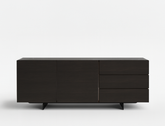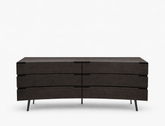Neutral Colours for a Calm Minimalist Space

Less is more may sound like a cliché, but when it comes to minimalist interior design, it rings especially true. Neutral colours are the key to achieving a serene, minimalist look in your Singaporean home. This design philosophy has gained immense popularity in recent years, and for a good reason: it’s not just about simplifying your space; it's about creating a peaceful oasis that promotes relaxation and mindfulness.
The Allure of Minimalist Design
The minimalist design movement is rooted in the idea of simplicity and functionality. It’s about stripping down a space to its essential elements, eliminating unnecessary clutter, and focusing on clean lines. The result is an environment that feels open, calm, and free of distractions. Minimalist homes are characterised by their lack of excessive decoration, with every piece of furniture and accessory chosen for its utility and simplicity.
However, achieving a minimalist look isn’t as easy as it might seem. It requires careful consideration of every detail in the room to ensure a balanced and harmonious design. The minimalist approach is not just about removing items; it’s about creating a purposeful and intentional space that feels both elegant and timeless.
The Role of Neutral Colours in Minimalism
Neutral colours are the unsung heroes of minimalist design. These understated tones—such as white, beige, grey, black, and brown—serve as the foundation upon which a minimalist space is built. Neutral colours are highly versatile and can complement various design styles, from modern to traditional, making them perfect for creating a cohesive and harmonious look.
Often referred to as earth tones, neutral colours evoke a sense of tranquillity and serenity, which is essential for creating a calming atmosphere in your home. Unlike brighter, more vibrant colours, neutral tones do not overwhelm the senses, making them ideal for fostering a peaceful environment.
When working with neutral colours, it’s important to pay attention to their undertones. Some neutrals have warm undertones, while others are cooler. These undertones can significantly impact how different colours work together in a room, influencing the overall mood and feel of the space. Additionally, incorporating texture and pattern through materials like fabrics or wall treatments can add depth and interest to a room without introducing too much colour.
Why Neutral Colours Are Essential in Home Décor
Neutral colours are not just aesthetically pleasing; they offer several practical benefits that make them a smart choice for home décor.
-
Versatility: Neutral colours can easily adapt to various design styles, allowing you to change up your décor without overhauling your entire space. You can use neutrals as a base and add pops of colour through accessories or artwork for a refreshed look.
-
Timeless Appeal: Neutral colours never go out of style. By using neutral tones as the foundation of your décor, you can create a space that feels timeless and sophisticated, no matter the current trends.
-
Calm and Inviting Atmosphere: Neutral colours help create a serene environment, making them ideal for promoting relaxation. Whether you’ve had a long day at work or just need a quiet space to unwind, neutral tones can transform your home into a calming retreat.
-
Easy to Accessorise: With a neutral colour palette, you can easily introduce different textures, patterns, and accent colours to personalise your space. This flexibility makes it easier to update your décor as your tastes evolve.
-
Enhancing Space: In smaller homes or apartments, neutral colours can make spaces appear larger and more open. They reflect light, creating an airy and spacious feel, which is particularly beneficial in compact Singaporean homes.
-
Showcasing Natural Materials: Neutral tones provide the perfect backdrop for highlighting the beauty of natural materials like wood and stone. These materials add warmth and texture to a minimalist space, creating a harmonious blend of nature and design.
-
Low Maintenance: Neutral colours are practical for everyday living. They are less likely to show dirt or wear and tear, making them easier to maintain over time.
Incorporating Minimalist Furniture into Your Home
Minimalist furniture plays a crucial role in achieving a streamlined, clutter-free space. The focus is on pieces that are both functional and visually appealing without unnecessary embellishments.
Prioritising Functionality
When selecting furniture, choose pieces that serve multiple purposes and enhance the functionality of your space. For example, a sofa bed in your living room can double as a guest bed, offering versatility without sacrificing style.
Embracing Simplicity
Minimalist furniture is all about simplicity. Opt for furniture with clean lines and simple shapes, avoiding ornate designs that can detract from the minimalist aesthetic. A low-profile platform bed, for instance, can create a sleek and modern look in your bedroom.
Sticking to Neutral Colours
To maintain a cohesive look, select furniture in neutral colours like white, beige, grey, or black. These tones not only complement the minimalist design but also help to create a unified and harmonious space.
Choosing Natural Materials
Furniture made from natural materials like wood, metal, or leather aligns perfectly with minimalist principles. These materials are not only beautiful but also durable, ensuring that your space remains eco-friendly and sustainable.
Balancing Negative Space
Negative space—the area around and between furniture pieces—is essential in minimalist design. When arranging your furniture, consider how each piece interacts with the surrounding space. A minimalist bookshelf, for example, can add interest to a room while maintaining a sense of openness.
Investing in Quality Over Quantity
Rather than filling your home with numerous items, focus on investing in a few high-quality pieces that will stand the test of time. This approach not only enhances the functionality of your space but also contributes to a more sustainable lifestyle.
Embracing the Beauty of Minimalism in Your Singaporean Home
Minimalism is more than just a design trend; it’s a way of life that can bring a sense of calm and clarity to your home. By focusing on neutral colours, clean lines, and functional furniture, you can create a space that feels both elegant and inviting. The beauty of minimalism lies in its simplicity, which can help you reduce stress, declutter your mind, and improve your overall well-being.
In a bustling city like Singapore, where space is often at a premium, embracing a minimalist approach can transform your home into a sanctuary of peace and serenity. Whether you’re starting from scratch or looking to refresh your existing décor, the principles of minimalist design can guide you in creating a space that is both stylish and functional.
FAQs on Minimalist Interior Design with Neutral Colours
Q: What are the best neutral colours for a minimalist home? A: The best neutral colours for a minimalist home include shades of white, beige, grey, black, and brown. These colours create a calm and cohesive environment that complements the minimalist aesthetic.
Q: How can I make a small room look bigger using neutral colours? A: To make a small room appear larger, use light neutral colours like white or beige. These shades reflect light, creating a sense of openness and making the space feel more expansive.
Q: What furniture is essential for a minimalist home? A: Essential furniture for a minimalist home includes a comfortable sofa, a simple dining table, a platform bed, and functional storage solutions. Each piece should be chosen for its practicality and clean design.
Q: Can I incorporate patterns in a minimalist home? A: Yes, you can incorporate patterns in a minimalist home, but they should be subtle and not overpower the space. Consider using patterns in textiles like rugs, cushions, or throws, in neutral tones to maintain the minimalist aesthetic.
Q: How do I keep a minimalist home from feeling too stark or cold? A: To avoid a stark or cold feeling, incorporate natural materials like wood or stone, and add texture through soft furnishings like cushions, rugs, and curtains. This will add warmth and comfort to your minimalist space.
By embracing the power of neutral colours and minimalist design principles, you can create a serene and sophisticated home in Singapore. Whether you’re starting fresh or refining your existing space, the minimalist approach offers endless possibilities for enhancing your living environment. Remember, in minimalism, less truly is more.







